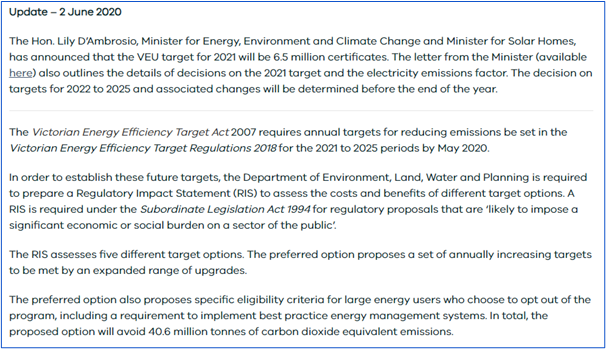The history of Large Energy Users/Scheduled Activity Premises under the Victorian Energy Upgrades (VEU) Program
Past, present and future?
Past: EREPs excluded
In December 2013, the EREP program ceased to operate, however large energy users which qualified under that program continued to be excluded from the VEU program.
From 1 August 2017, excluded sites are able to opt-in to the VEET scheme.
Regulatory Impact Statement Victorian Energy Efficiency Target Amendment (Prescribed Customers and Targets) Regulations 2020.
Present: Automatically excluded, optional inclusion
In December 2019, as part of target setting for the Victorian Energy Upgrades (VEU) program, the Department of Environment, Land, Water and Planning released a Regulatory Impact Statement. This document proposed that large energy users no longer have the choice to be exempt from the program, unless they are trade exposed, exceed specified consumption thresholds, and implement ISO 50001 or energy management that meets an equivalent standard.
Regulatory Impact Statement Victorian Energy Efficiency Target Amendment (Prescribed Customers and Targets) Regulations 2020.
In June 2020, the Minister for Energy, Lily D’Ambrosio announced the VEU targets and mentioned the new eligibility criteria for large energy users opting out, however, this was not implemented at the time.
In April 2021, an update was given stating that further consultation was required regarding the LEU eligibility, and that subject to this further consultation, a new framework would be announced in late 2021.
On 30 June 2022, DELWP announced a timeline for new and revised activities under the VEU program listing that consultation for the Large Energy User Framework was scheduled for Q3 2022 onwards (Q3+)
On 4 July 2022, DELWP released the Gas Substitution Roadmap which referenced the inclusion of LEUs in the VEU Program, stating that this was something that was going to happen. No timeline was given, but the terminology was more certain than it has ever been previously.
On 2 August 2022, the VEU team released an email announcing that the consultation on any potential changes would not occur in 2022, and as such, the VEU program exemption framework would not change in 2022. At the same time, the DELWP timeline for new and revised activities was amended to remove mention of the LEU Exemption Framework.
Future: Where is this heading?
Our expectation is that, provided a Labor government is returned in November 2022, the consultation on LEUs participation in the VEU will recommence in early 2023.
LEUs should be thinking about implementing Energy Management Systems in anticipation of changes to the VEU whether the LEU wishes to Opt In or Out.
Energy Management Systems take significant time and resources to implement properly to meet an accreditation or standard.
There are many benefits to improving your metering and energy management systems including:
Ensuring you are ready to access any grant or incentive opportunities for energy efficiency or fuel switching upgrades
Enabling faster and more accurate independent verification of contractor’s energy savings estimates (hold your contractors to account)
Improving your long-term planning by leveraging historic performance and trends
Data driven decision-making supports your ability to prioritise upgrades, make decisions regarding opting in SAP sites, and make the highest value capital investment
Having all your data in one place saves significant amounts of time and resources when carrying out research and reporting tasks
High quality data visualisation and in-built alerts enables faster identification of anomalies and opportunities








